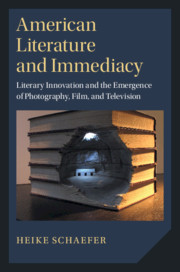 American Literature and Immediacy
American Literature and Immediacy Book contents
- American Literature and Immediacy
- Cambridge Studies in American Literature and Culture
- American Literature and Immediacy
- Copyright page
- Dedication
- Contents
- Acknowledgements
- The Quest for Immediacy in American Literature and Media Culture
- Part I Literary Immediacy and Photography
- Chapter 1 The Poet as “Exact Reporter of the Essential Law”: Ralph Waldo Emerson’s Poetics in the Context of Early Photography
- Chapter 2 “To Exalt the Present and the Real”: Walt Whitman’s Photographic Poetry
- Chapter 3 The Politics of Paying Attention: The Romantic Desire for Immediacy
- Part II Literary Immediacy and the Cinema
- Part III Literary Immediacy and Television
- Notes
- Bibliography
- Index
- Series page
Chapter 2 - “To Exalt the Present and the Real”: Walt Whitman’s Photographic Poetry
from Part I - Literary Immediacy and Photography
Published online by Cambridge University Press: 19 December 2019
- American Literature and Immediacy
- Cambridge Studies in American Literature and Culture
- American Literature and Immediacy
- Copyright page
- Dedication
- Contents
- Acknowledgements
- The Quest for Immediacy in American Literature and Media Culture
- Part I Literary Immediacy and Photography
- Chapter 1 The Poet as “Exact Reporter of the Essential Law”: Ralph Waldo Emerson’s Poetics in the Context of Early Photography
- Chapter 2 “To Exalt the Present and the Real”: Walt Whitman’s Photographic Poetry
- Chapter 3 The Politics of Paying Attention: The Romantic Desire for Immediacy
- Part II Literary Immediacy and the Cinema
- Part III Literary Immediacy and Television
- Notes
- Bibliography
- Index
- Series page
Summary
Whitman adopted photography as a model for literary practice. By emulating the immediacy effects and truth claims of photography, Whitman developed an innovative style that aimed to endow his poems with the same qualities he valued in the new medium—particularly directness, accuracy, naturalness, and inclusiveness of representation—and the cumulative experience of these qualities by the beholder as a sense of authenticity, media transparency, and immediate encounter. Comparing the representational powers of photography and literature helped Whitman to gauge the spiritual, cultural, and political function of literature. The chapter presents Whitman’s turn towards immediacy as part of his attempt to renew and democratize American poetry. It argues that Whitman’s engagement with photography led him to create a poetic style that allowed him to address the particulars of time and place, to take the details of everyday life as his subject matter, and to invest them with an egalitarian ethos by staging the dynamics of literary communication as a model for democratic social interaction. In Whitman’s work, the appeal to immediacy thus gains a decidedly political momentum.
Keywords
- Type
- Chapter
- Information
- American Literature and ImmediacyLiterary Innovation and the Emergence of Photography, Film, and Television, pp. 69 - 88Publisher: Cambridge University PressPrint publication year: 2020


